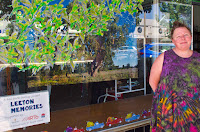Last weekend was Burning Seed, the NSW Burning Man event, and I got a small grant to build a collection of over 100 wind organs.
"Organ Donor" was the name for the collection and came with a message in the program about donating organs to save lives.Recent installation
Post Your History
Griffith Pioneer Park Museum is seeking out those who remember the old Post Office in Griffith, as part of their new display
The Post Office was on the site of the current building, but an older style with red brick and grand arched windows.
Pioneer Park Museum has a recreation of the original Griffith Post Office which was operational from 1925 to 1979 with staff keen to talk to those who have stories to tell about the original building.
“We’re currently developing new displays with a focus on the Post Office and would love to be able to share memories, stories, experiences and anecdotes to preserve this important part of our local history,” said Jason Richardson, Curator Griffith Pioneer Park Museum.“Do you have memories of the Griffith Post Office? Maybe you received an important telegram, or worked behind the counter? We would love for you to share any stories you might have.”
Postal services at that time included technologies not seen today, like telegraph operators communicating through the percussive messaging of Morse Code. Aside from parcels and letters, the building also housed the switchboards used to link telephones in the region.
“Those who lived on farms might remember the distinctive ringing of their party line, which indicated when a phone call was for their household rather than another that shared the connection,” said Mr Richardson.
There are many ways the Post Office connected Griffith and it’s surprising to discover what services were provided in the building.
“Phyllis Bell recently recalled working as Phonogram Operator for seven years and says her colleagues were the nicest people,” he said.
“She remembered that as she progressed to being a senior staff member, her role included liaising with the CSIRO to update weather reports placed at the front of the Post Office.”
Memories like these will help the new display to reflect how important services within the community have changed.
“It’s details like these memories that help Pioneer Park Museum to share the experiences of the local people who shaped our history,” said Mr. Richardson.
If you have a recollection of the Griffith Post Office, please contact Pioneer Park Museum.
Leeton Memories bring colour to history
A visually-arresting and innovative approach to local history will debut in Leeton this March
Local artist Jo Roberts has a display in the windows of the Leeton Community Op Shop that is based on the memories of longtime resident Joe Errey.This is the first of a series of window displays that, over coming months, will interpret observations from elders about their lives in our town and bring into focus changes in the local landscape.
"This project began with a conversation I had with Joe Errey," said Jo Roberts.
"We're both keen observers of birds and I was enthralled by his descriptions of flocks of birds, particularly those that are now rarer to see over our town."
Joe's memories include seeing flocks of budgerigars, as well as identifying a River Red Gum planted in 1913 by his grandfather at their former farm.This towering giant sits a little way off Vance Road and marks the beginning of the Errey family's connection to Leeton after they settled on the land.
"I was also amazed to learn that Joe's pet corella is more than 50 years old, which seems mind-blowing when you consider how common these birds are in our region," said Ms Roberts.
The bird, named Sam, can often be heard calling out to those passing by Joe's home on Brady Way.
The Leeton Memories project has collaborated with Kathy Tenison of Storymaster Audio to record interviews that capture local history from the perspectives of older residents, then Red Earth Ecology offered these conversations to local artists for interpretation as visual displays.
"Our aim is to stir discussion about changes in the local landscape by reflecting on what people have seen in their own lifetimes," said project coordinator Jason Richardson.
"It's exciting to see how those memories resonate with our collaborators, such as the artists involved and through listening to the recordings with Leeton writers at Riverina Writing House."
The project brings an intergenerational approach to interpreting recent history of the region in various media.
"We have thoroughly enjoyed getting to know these residents through hearing about their lives and hope that everyone in the community will take the time to listen, while looking over the dynamic displays during the next few months," said Mr Richardson.
A link to hear Joe's memories online will be seen in the form of a QR code in the window display, allowing viewers to hear his observations while looking over Jo's interpretation in the Leeton Community Op Shop windows during March.(Or click on this link https://soundcloud.com/red-earth-ecology/joe-erreys-leeton-memories)
And, if you listen carefully, you can hear Sam the corella calling in the background.
Red Earth Ecology has been actively fostering connections with the Riverina landscape for around a decade through a range of activities, see ree.org.au for more.
Leeton Memories is supported by Western Riverina Arts and Create NSW through funding from the NSW Government.




